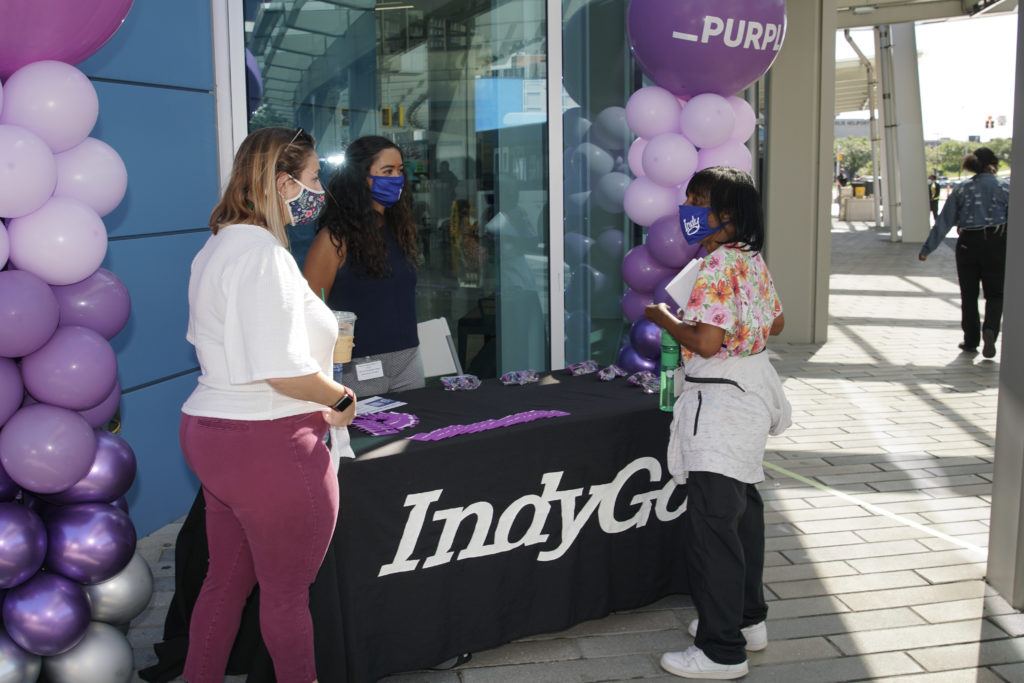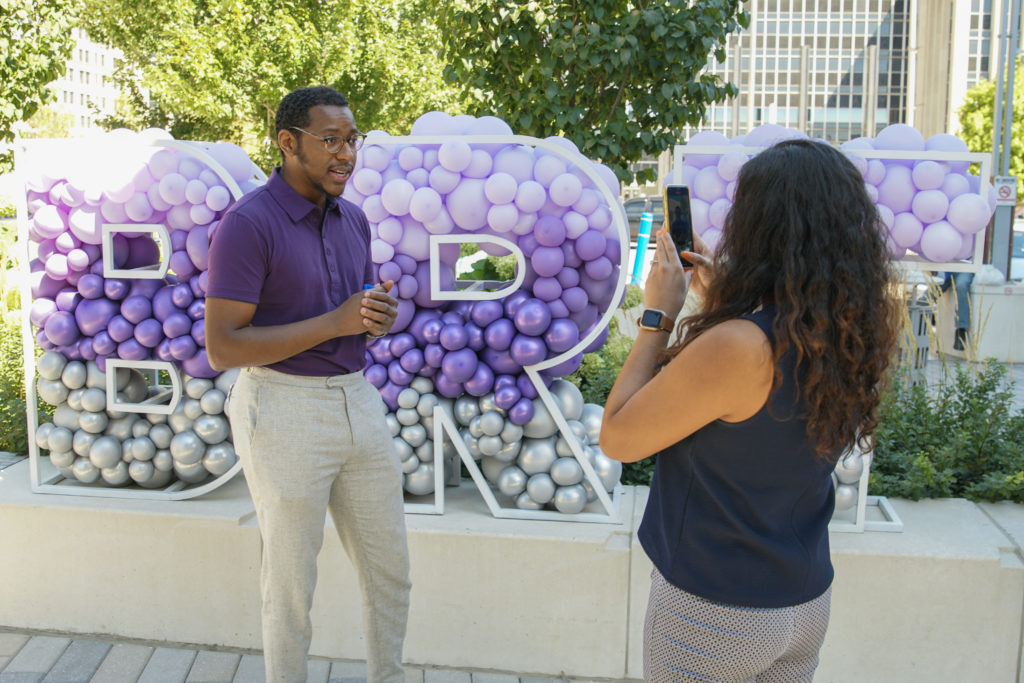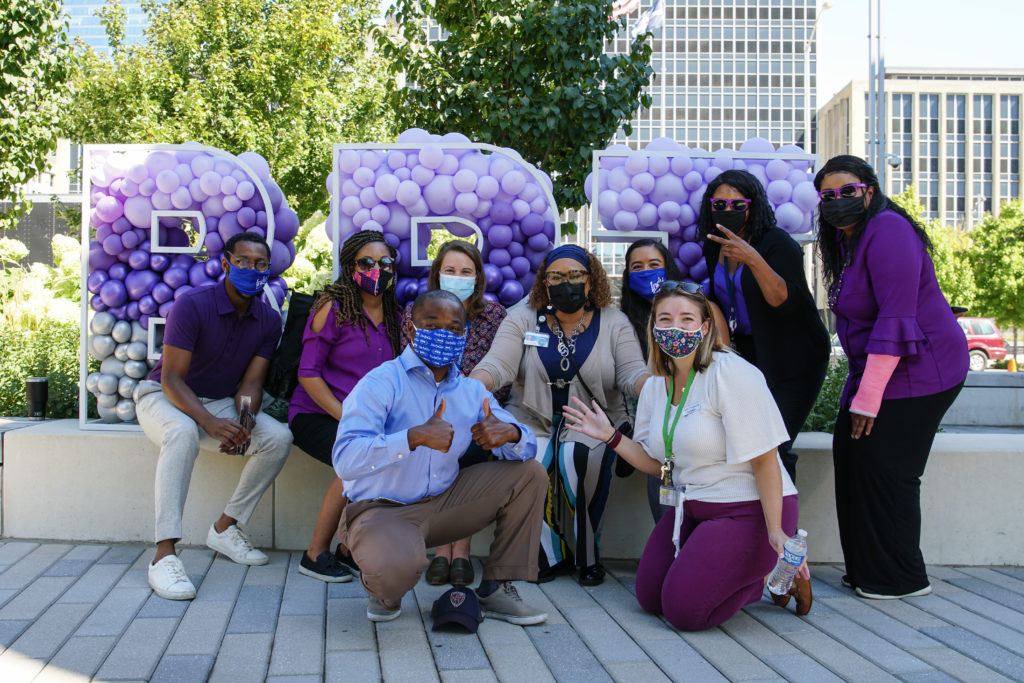Katrina Ent is an early communications professional, digital storyteller and relationship builder. She’s also a dedicated member of the IndyGo team where she sits at the helm of communications for our city’s transit system. I got to sit down with this changemaker to learn more about her Indy story, working in public transit, and being a young professional in Indy.

Hannah Thomas: At IndyHub, our motto is People Make the City. Tell us more about your Indy story! Can you start by sharing why Indianapolis is the place you choose to call home?
Katrina Ent: It’s funny to see how much my Indy story has evolved since living here at five-years-old. If you asked me this question while I was in high school, I would’ve said, “Indiana only has cornfields and race cars. There’s nothing much to this fly-over state!” But as I entered through college and attended many social networking events on campus and in Indianapolis, my perspective quickly changed simply because of the people I was meeting within our city. Everyone I ever interacted with only said incredible things about Indianapolis. Sure— Indianapolis was known for the Indianapolis Motor Speedway and 500, but the fascinating part about the Indy 500 is the traditions and the life-enriching events people would attend to celebrate our community. I choose Indianapolis as my home because of the people and traditions. It’s an indescribable experience you can’t get in any other city.
HT: Tell us about your 9-5 at IndyGo! What’s your role and what does your day-to-day look like?

KE: I serve as the Digital Media Specialist for IndyGo. Within my role, I manage the overall voice and tone of the agency through all social channels, update and audit content that lives on our website, and share our story through the various advertising vendors we work with. My day to day always changes, which is exciting— I don’t like having the same routine every day! Essentially, my 9 to 5 focuses on creative writing and relationship-building with people— whether it’s virtually or in real life.
HT: Becoming a public servant grants a different perspective on the city you call home. This past year has been unlike any other. Your work is centered around connecting our city’s residents to economic and educational opportunities and enhancing their quality of life. What’s something new you learned about Indy since you started on the team at IndyGo?
KE: Since joining IndyGo, my perspective has changed dramatically regarding public transportation. Before joining the team, I would’ve thought nothing more than that IndyGo takes people to where they need to go. Within my first few weeks, after chatting with various colleagues in different divisions and participating in our outreach events, I quickly realized that this is more than just transporting people from point A to point B. Working in public transportation allows people to visit the many economic and educational opportunities Indy has to offer. There’s a sense of community when people are riding the bus together. I quickly realized how much people advocate for transit and how this service is changing people’s lives. I would’ve never guessed this role would pull on my heartstrings so much. Many riders have cool stories to share, and I feel honored to share their stories with others.
HT: Public transit is at a tipping point. The road ahead potentially holds the biggest barriers and greatest opportunities in our city’s history. How does it feel to be a 20-something working on the transformational infrastructure that is arguably one of the most important public assets for our community?
KE: As a 20-something working in the transit industry, I feel an enormous sense of responsibility. There are times where I feel like the work we do is rewarding, but there are also times where I feel like there’s more that needs to be done. However, seeing the amount of support we receive from our partners, advocates, and riders makes the high-pressure of this job worth it. Not everyone has the same opportunities as others. Many people don’t have the luxury of owning a car. So, to have transit service for our city is exceptionally crucial. To bring improved transit access to those who may not be able to afford it or who do not choose to maintain their own car is imperative to keep the people who make our city great.
HT: The pandemic has hit so many industries hard. In what ways has IndyGo balance the pandemic struggle and keeping up momentum for new, and innovative projects?

KE: IndyGo took swift action to keep riders and staff safe when the pandemic began. While we did temporarily reduce service and suspend fare collection, IndyGo worked hard to innovate and provide new safety measures such as protective shields for Operators, which allowed us to return to normal service. We’ve also increased our cleaning measures. And we’ve seen riders continue to use the service throughout the pandemic, so we know how important it is to continue providing transit service for those essential workers in our community.
While we faced a few challenges during this pandemic, luckily, we could get creative and find new ways to reach our riders. Pre-pandemic, we hosted many outreach events throughout the city, educating and informing riders about our transit services. While we may not be able to interact in person like in past times, we were able to host more outreach events virtually versus when we did these events in person. We would either host Facebook live events or promote in advance virtual events. The other benefit of hosting these virtual events was that people could access the video anytime it was convenient for them. When we hosted in-person outreach events, many people couldn’t commit to the time, location, or both.
In addition to hosting more virtually-wide events, we were able to launch an entirely new fare-system, MyKey, all digitally—from a virtual public meeting to a video educational series known as “MyKey University” that lived on our website and YouTube channel. Following these virtual approaches has allowed us to keep better track of metrics.
HT: The IndyGo MyKep app launched during the height of the pandemic. Can you tell us more about this exciting new technology for riders?
KE: Yes! MyKey is our new account-based fare-system. When it comes to paying for fare, riders can now do it all through an app on their phone or through a tap card. Having this new pass with perks is extremely convenient for our riders. We have almost reached the completion phase of upgrading our ticket vending machines. Stay tuned on our social media pages to see when those ticket vending machine upgrades will be completed!

HT: What else can our community do to support IndyGo and our entire transit system?
KE: If you or someone you know has a cool story when it comes to transit, let us know! We want everyone’s stories to be heard. Many people genuinely don’t understand the benefits of transit until they hear someone else’s story on how public transportation has changed their lives. For those interested in sharing their story, visit indygo.net/essential for details.
HT: Who is someone in Indy that you’ve felt has paved the way for you over the years?
KE: The first person who comes to mind would have to be my first boss in my professional career. When I was the marketing intern for Hendricks County Community Foundation, my boss, Ericka Bethel, paved the way for me to grow and advance in my career. She completely trusted me and let me take ownership of all the projects I worked on. She worked part-time as the Communications Manager, so I took that as an opportunity to work full-time and take on any projects she needed. Not only did she show me how to get connected within Hendricks County, but she also showed me the opportunities that I could take advantage of in Indianapolis. She always pushed me to think differently and apply for the internships I didn’t think I was qualified for. Ericka helped set the foundation for me when I started my career. As any home builder would say, you can’t build the house from the ground up if you don’t have a foundation to start with. Ericka helped build my foundation for my career, and since then, I’ve been able to build my ideal career house ever since.
HT: What do you love about Indianapolis?
KE: It is cliché to say, but I describe my love for Indianapolis similarly to how I share my love for my undergrad Ball State University. When I was a tour guide, parents or prospective students would ask me how large the student population was. When I was asked this question, I would answer it like this: “If you want to attend a somewhat large university but not a small-town university, Ball State is the perfect balance of both of those communities. We aren’t large where you feel like you can’t feel a sense of belonging or too small where you feel like you know just about everyone.” The way I described the student population at Ball State is how I express my love for Indianapolis. I think, even for an Indy Transplant, they could agree to this—there is a sense of community and belongingness when it comes to Indianapolis. Anyone you come across, they just so happen to know your best friend’s brother. While Indianapolis is physically large on the map, it’s small enough for everyone to find commonality with just anyone, anywhere. Some people don’t hype up Indianapolis as much as they should. Just like my 15-year-old self, many people would be surprised by what Indiana has to offer, not just cornfields and race cars.





